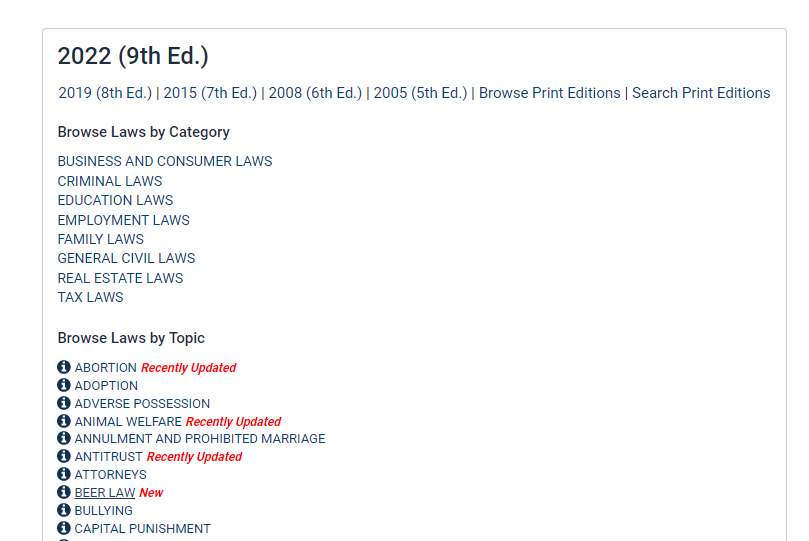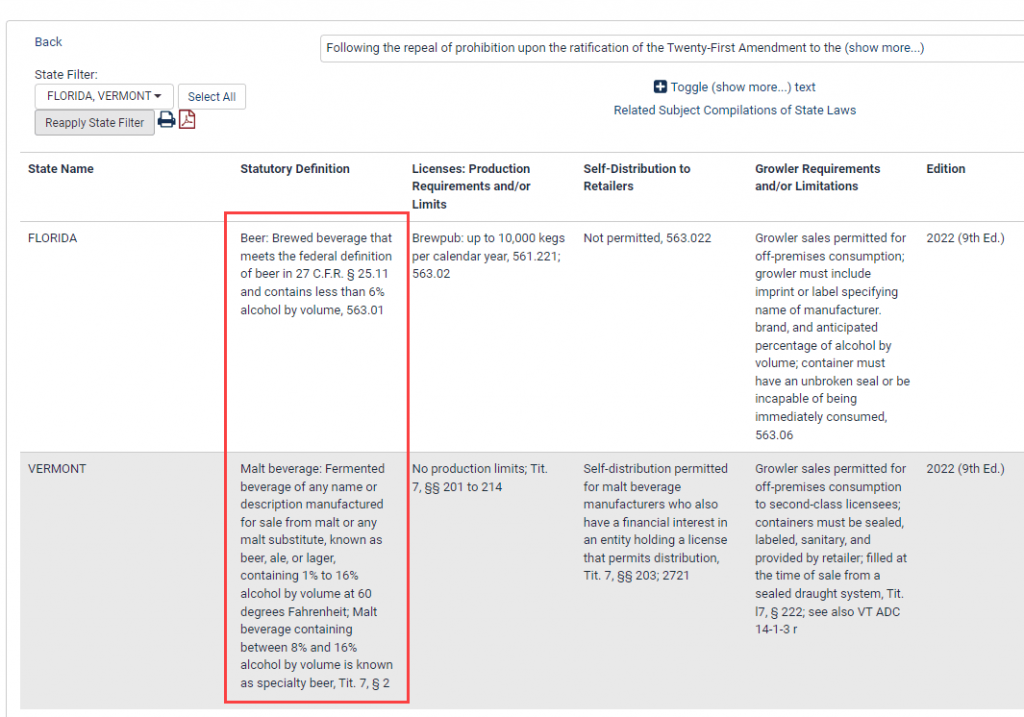Following the repeal of Prohibition with the Twenty-First Amendment, alcohol production, distribution, and sales faced intense scrutiny at both federal and state levels. The federal government retained significant authority under the Commerce Clause and the states gained substantial regulatory power over alcohol within their borders. The variety and complexity of laws in this area make a state-by-state review of the most fundamental elements of this industry particularly interesting and useful.
What better day than today, National Beer Lover’s Day, to delve into the fascinating world of beer laws across the states? We’ll be your guide through the maze of beer regulations, using National Survey of State Laws—a trusted print and online resource known for shedding light on some of the most asked-about and contentious legal topics in the United States. Get ready to impress your friends at the brewery later with your newfound knowledge of beer regulations from coast to coast.
A Sud-Sational Start
The legal definitions pertaining to beer carry substantial implications for the beer production and sales industry within individual states. In some instances, they pivot on the specific ingredients employed in the brewing process, while in others, the emphasis is placed on the alcohol content of the final product. The ability to manufacture specific alcoholic products and the regulations surrounding their sale, including where and how they can be acquired, often hinges on the terms outlined in statutory definitions. So let’s tap into the laws.
Upon entering the National Survey of State Laws database, users will find the option to browse laws by category or by topic. Under the list of topics, you will find a brand-new chapter on Beer Law.

Within this chapter, the tables focus on particular aspects of the law such as licenses, self-distribution to retailers, and growler requirements and/or limitations.

As you can see by the statutory definitions, each state drastically differs. Let’s take a sample and compare the differences. Check the states Florida and Vermont, and then select Show only checked states.
TIP: To see this in action, check out this short tutorial.

For example, Vermont’s definition includes a fermented beverage of any name or description manufactured for sale from malt or any malt substitute, known as beer, ale, or lager, containing 1% to 16% alcohol by volume at 60 degrees Fahrenheit; Malt beverage containing between 8% and 16% alcohol by volume is known as specialty beer. On the other hand, Florida’s definition is a brewed beverage that meets the federal definition of beer in 27 C.F.R. 25.11 and contains less than 6% alcohol by volume. In case you’re wondering, the Code of Federal Regulations defines beer as beer, ale, porter, stout, and other similar fermented of any name or description containing one-half of one percent or more of alcohol by volume, brewed or produced from malt, wholly or in part, or from any substitute for malt.

Growlers: Tapped and Tracked
If you’re not familiar with the term, the word “growler” means a refillable and sealable container for alcohol. Despite the extensive legislation, regulation, definition, and control surrounding alcohol, the laws governing the sale of growlers by breweries for off-premises consumption remain ambiguous or entirely unspecified in numerous states.
For example, we can see from the overall chart that most states allow for growler sales for off-premises consumption, except for Idaho, which makes no mention of growler sales in its statute. In Washington, growler sales are not permitted in public houses but are within microbreweries. What’s more, in Pennsylvania you need a special permit to sell a growler.
Indiana imposes a unique growler sale limit of 576 ounces per customer, but only on Sundays. You can purchase a growler in Nebraska as long as it’s under 32 ounces and was purchased from a licensee or exchanged for a previously purchased container. But, if you really want to get hoppy, we recommend taking a trip to Wyoming where the max volume is 2,000 ounces per sale.
A Bitter Brew?
As of 2022, there are more than 9,500 breweries across the United States. These breweries vary in their beer varieties, sourcing of raw materials, and legal classifications, resulting in diverse rights and duties for different types of beer makers. Production restrictions often spark disputes among producers and between brewers and the government, resulting in frequent proposed changes to laws and regulations.
In California, a brewpub restaurant must have a 7-barrel minimum production per brewing cycle, while Vermont has absolutely no production limits. In Louisiana, you won’t find any high-percentage beers as they don’t allow the production of anything more than 6% alcohol by volume. Ohio’s Permit A-1 or A-1c holders are in for a marathon, needing to brew a whopping 31 million gallons yearly. For those seeking liberation from limits, Oregon’s beer enthusiasts revel in a regulation-free brewing state. What adds an intriguing twist is that farm breweries in New York State are limited to selling beer with a New York State label.
Pour Me Some More
In the world of beer law, navigating the intricate web of state regulations can be as complex as crafting the perfect brew. The legal landscape is ever-evolving, not just for beer but also for other trending topics in the news. To stay up-to-date with the various state-wide laws, subscribe to our must-have guide, National Survey of State Laws 9th edition, where you can explore topics such as abortion, gun control, unclaimed dead bodies, and more.
Print & Online Access:
Order the 9th Edition and receive immediate access to the online database. This one-time purchase provides access until the next edition is published.
1 Print Copy & Online Access for 1 Location…………………………………..………..….…..$265.00*
Additional Print Copies………………………………………………………………………….…..…………$105.00
*The price above does not include shipping and handling.



